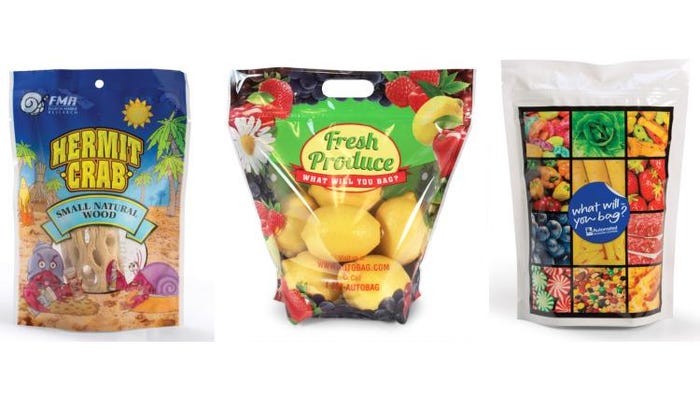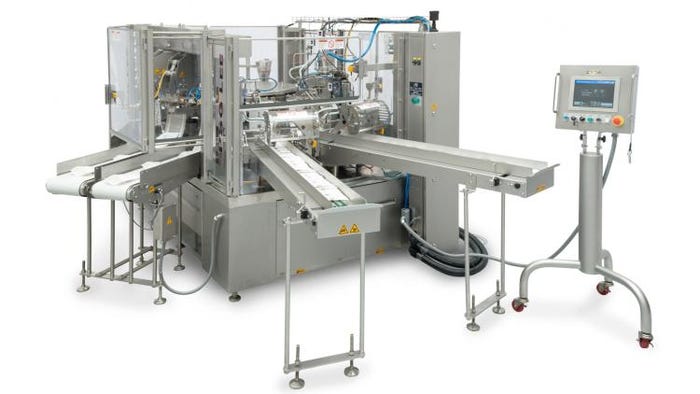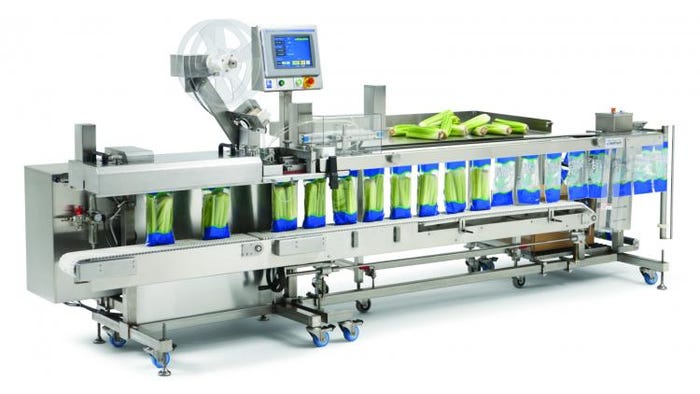Packagers’ desire for less packaging waste and greater operational efficiency, including improved infeed systems, is driving advancements in premade-pouch fillers/sealers.
Packaging Digest asked executives from three equipment companies to answer a few questions about recent improvements in this corner of the packaging-machinery market and to predict what we can expect in the near future.
The participants in this exclusive Packaging Digest roundtable are:
• Mike Burnett, senior product manager at Automated Packaging Systems;
• Troy Snader, vp, Flexibles, at Matrix/ProMach; and
• R. Charles Murray, CEO of PPi Technologies Group.
What recent advancements have you seen in premade-pouch fillers/sealers?
Burnett: The laminated stand-up pouch segment has exploded over the past five to 10 years. Never before have we seen so many innovations in terms of material structures and bag features, including barrier films, high-respiration films, specialty closures, fitments/spouts, shapes and sizes. This innovation in flexible packaging materials has also driven the need for innovation in the form, fit and function of the machinery used to package customer products in the most efficient and effective ways possible.

Examples of premade standup pouches from Automated Packaging show variety in the format.
Packaging machinery buyers/users are constantly being challenged by ever-increasing labor costs and ever-decreasing labor availability. We’ve seen a significant increase in the demand for more custom, integrated systems in which our bagging machinery is fully integrated with various types of automatic infeeds—counters, weighers, fillers and robotics. Having the capability to use automatic infeeds significantly reduces the number of people required to operate each piece of equipment on the packing line.
Snader: We distribute the Toyo Jidoki brand (see photo at the top of the page). A recent advancement is a new recycle-pouch option. When a bag is not filled, instead of just dropping, the bag continues through each rotary station without being sealed or dispensed. The bag continues through the next cycle and is then filled, sealed and dispensed the second time around.
Another advancement is in the adjustability of the heights of the pouches and seal bar/cooling bar. This allows for much greater flexibility with zipper pouches.
Yet another advanced feature is the “pause” mode. In this mode, if a pouch is opened, the process will pause or wait for the fill, as needed. That way you remove the possibility of an empty pouch.
Murray: The marketplace has called for more speed, and our new servo-driven PSG LEE fill-and-seal machines run at 120 per minute.
Supplying prepared home food products as kits has created the need for two-compartment pouches. Amazon is pushing online delivery of healthy food kits—home deliveries have doubled in the past year. We can fill, in duplex, two pouches at a time, each with two compartments, and also up to four different products at a time. The scale feeds these products. We can also gas flush to extend shelf life.

The PSG LEE RD-320 premade-pouch filler/sealer, distributed by PPi Technologies Group, is a duplex machine with 10 stations.
How do these advanced systems compare to existing, standard equipment?
Burnett: Most of the flexible-packaging industry is comprised of companies that focus either on packaging materials or packaging equipment. With today’s rate of innovation, some companies, like Automated Packaging Systems, are designing and engineering materials and machinery together for highly optimized applications, such as stand-up pouches. Using system-matched materials improves productivity, throughput and reliability.
Snader: Existing equipment does not have a recycle option; bags that are not filled are dropped, generally inside the machine, or they carry through to the end of the cycle and are ejected. If the pouch is ejected at the end of the cycle, there is a possibility of reusing the bag. But if it is ejected within the machine, and the product—perhaps a messy, powdery product—gets all over the pouch, then the pouch would need to be disposed of. These bags are not reused.
Being able to adjust pouch and seal bar/cooling bar heights expands the equipment’s capabilities. Most premade-pouch machines have some flexibility with adjustments, but they’re limited. Also, pause mode is not available on other machines.
Murray: The ability to produce, with the new servo-drive machines, twice the run output with the same single operator provides an excellent return on investment—ROI. These machines also have the ability to open zippers that might be closed during pouch manufacture, using a patented mechanical opener. This reduces pouch waste before filling.
What are the benefits of these advancements for packaging machinery buyers/users?
Burnett: The main advantage to premade-pouch fillers/sealers is that these machines take the bag-making process out of the equation. Not having to make the bag removes a lot of complexity from the machinery, usually resulting in a less intense capital investment. Also, premade pouches typically look better and are often higher quality, because the pouches are made offline on specialized bag-converting equipment instead of in-line with the packing-line operation.
Automated Packaging Systems’ FAS SPrint Revolution SidePouch platform is an example of a high-productivity bag-packaging system that has been optimized at the design and engineering phase to run multiple bag formats, including stand-up pouches, with integration capabilities for maximum labor savings.

Automated Packaging Systems’ FAS SPrint Revolution SidePouch bag-packaging systems for premade, stand-up pouch applications run multiple bag formats, including stand-up pouches and non-structured bags.
Snader: Using equipment with a recycle-pouch option helps customers decrease pouch waste; the programming allows for maximum efficiency of the filling/sealing process. A lot of programming goes into the system when it needs to recognize that the bag was not filled and needs to continue to cycle around the rotary path without closing, sealing or dropping on the conveyor.
Equipment with height adjustability offers more flexibility and options when it comes to design of pouches and the number of different pouches you can run on the same machine.
Murray: The first benefit of a duplex machine is making two pouches at about 35% less cost than a single pouch, which means a price reduction for the owner and/or consumer. The equipment’s ability to open all zippers means pouches are always filled, and the machine runs at optimum efficiencies. A duplex washdown machine has an advantage for the environment in that there is about a 50% reduction in chemicals going into the waste stream, because only one machine is washed and sterilized.
What areas in premade-pouch filling/sealing still need work, and why?
Burnett: Footprint, flexibility and speed are a few areas in which premade-pouch filling/sealing machinery could improve. Many machinery options in this space still require a fair amount of real estate, aren’t particularly quick to change over and leave a bit to be desired in terms of packaging efficiency.
We are always looking at how our customers’ needs are changing and are likely to change in the future so we can develop new products to meet or exceed those needs.
Snader: Customers looking for an entry-level machine have a difficult time finding one that will work efficiently, is reliable and has more than the minimum durability. Most entry-level machines have a low operating efficiency, a greater number of unfilled bags that are dropped and a larger number of bags that are not sealed correctly, which results in disposal.
Second, pouch-infeed systems need advancement. Current systems are extremely costly and unattainable for most customers.
Third is washdown. Improvements to materials and design are needed to ensure machine integrity in a washdown environment.
Murray: In the near future, the premade-pouch machines will need automatic, robotic premade-pouch loading into the filler.
The premade-pouch machines will need to accommodate more camera vision systems to ensure quality and that correct products are packed.
What’s next, and when might we see further improvements in premade-pouch filling/sealing?
Burnett: We are always looking for opportunities to innovate and create more value for our customers, and everything is on the table: enhanced focus on predictive-maintenance features, productivity-data tracking/export, IoT [internet of things], even simpler maintenance, food safety. These, and more, are all focuses for us as our product road map evolves.
Snader: As customers move into the premade-pouch market, we will continue to see a greater number of additional features. These features are often created in response to the needs of new customers and the complexity of their packaging needs. One example is off-set transitions, when you want the equipment’s fingers to pick up the bags slightly off-center, or off-set, for transitioning through the cycle.
We also continue to see new and better options for printing—for example, how the machine is set up, in terms of new standard connections that make it easier to connect a larger variety of printers. The need for increased speed will drive continuous improvement as more efficiencies are put into place.
Automated, robotic infeeds and higher-capacity infeed solutions will continue to be advanced for automatically feeding premade pouches into machines. Customers are looking for less labor in feeding premade pouches into machines. The largest manufacturer of premade-pouch machines is launching an automated, robotic infeed system in the second quarter of 2019.
Murray: The future is premade-pouch machines that work with other filled primary packages, namely stick packs, vials or tubes, loading a pre-counted quantity into the premade pouch for retail sales. This avoids the need for a paper carton box. The premade pouch is much more flexible than a carton box. The same size pouch (as carton box) can handle many pack sizes.
********************************************************************************
EastPack 2019 (June 11-13) is the region's premier packaging event connecting professionals from companies like PepsiCo, Pepperidge Farms and Mars with suppliers offering the latest packaging technologies, including a range of automation solutions, from semi-automatic equipment to sophisticated "smart" systems. Register to attend today!
About the Author(s)
You May Also Like




